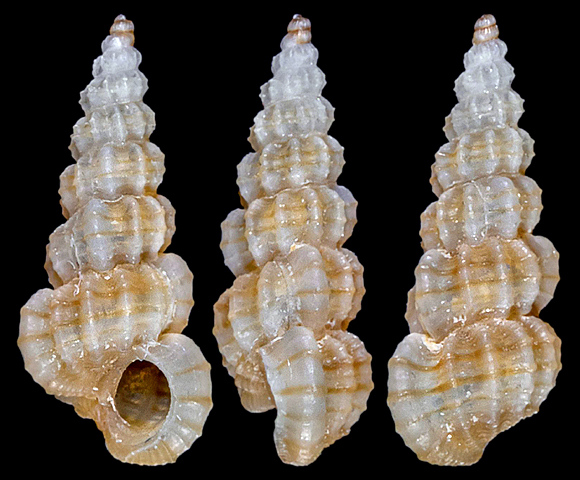
« Shell attenuate, strongly sculptured and imperforate. Whorls 14, moderately convex and attached. Color a dull brownish-white with the costae and the spiral ridges light-brown. Spire extended and produced at an angle of 23°. Columella short and arched. Aperture subcircular and slightly flaring below. Axial sculpture consisting of numerous and well developed costae […]. Nearly all whorls possess 1 or 2 costae which have become enlarged to form varices. Spiral sculpture consisting of 8 to 12 strongly developed spiral ridges which, on passing over the costae, form small nodules. In addition, there are numerous fine axial threads which are most prominent in the intercostal areas. There is a moderately developed basal ridge with both the axial and spiral sculpture continued below it, but not as strong as in the peripheral area. Nuclear whorls 3, dark amber-brown and axially costate. » – Clench & Turner: “The genera Epitonium (part 2), Depressiscala, Cylindriscala, Nystiella and Solutiscala in the western Atlantic”, Johnsonia vol. II, num.31, p.343.
300m deep, Gulf of Cagliari, S. Sardinia. 8mm.
Original pictures provided by A. Nappo (IT).
– (CC BY-NC-SA) –

O. atlantis has been found alive, attached to the column of an Actinarian Actinauge richardi (Marion, 1882), at about 550m deep, west of Malta (Mifsud, 2009). The shell of this species is close to that of the western O. rabalaisi García, 2005, but shows much more spiral cords (8-12 in atlantis vs. circa 6 in rabalaisi).
Above: young specimen from 140m deep, Ras ir Raħeb, northwestern coast of Malta. 4,5mm. Original pictures provided by D. Pellegrini (IT) – (CC BY-NC-SA).